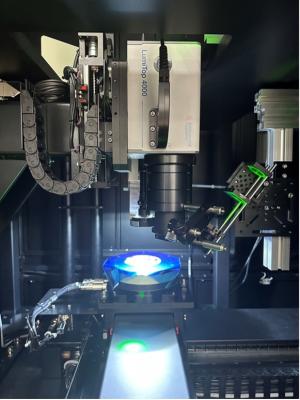We're happy to interview Tobias Steinel Ph.D., works as a product manager at Instrument Systems GmbH, as part of our series of interviews with MicroLED Industry Association members. Germany based Instrument Systems manufacturers high-precision spectrometers, complex systems and software solutions for spectral light measurements.
Tobias is responsible for Instrument Systems’ measurement portfolio in the field of microLED optical testing and AR/VR/MR applications.
Can you please introduce your company and technology?
With facilities in Munich and Berlin, Germany, Instrument Systems develops and produces high-end light measurement technology for flat panel displays, micro-displays, near-to-eye displays, automotive lighting, VCSEL systems and LED/SSL modules. Our color and light measurement solutions are used in display production sites worldwide. In addition to the manufacture of measuring equipment, our core competence is that our accredited test laboratory guarantees independent, reliable and comparable measurement results for every measuring device purchased. These can be traced back directly to the reference standards of national metrology institutes.
For our customers, this offers the considerable advantage of direct comparability of their own measurement results, regardless of the location of measuring stations or production lines. We apply this know-how to microLED technology, and seek to provide our customers with the best possible support in the production process, from wafer to display.
Can you say why you joined the MicroLED Association and what you hope to achieve?
At Instrument Systems, we believe that in the years ahead microLED technology will become an integral part of the display industry. For several years we have been working closely with customers to optimally gear our measurement solutions to the requirements of our customers, and to provide them with the best possible support. In contrast to the established OLED display industry, with a small number of key players in Korea, China, Taiwan and Japan, the ecosystem for microLED technology is more diverse and offers opportunities to many companies in the supply chain. We believe that the MicroLED Industry Association is an excellent way of connecting all companies in the value chain for their mutual benefit. With every technology change, the first major goal is to develop the technology to make mass production economically viable. Our contribution to the industry in pursuit of this goal is to support the quality requirements of our customers with suitable measurement solutions. We are investing our many years of experience in the field of display test solutions for high-volume applications with the aim of further expanding our network and thus advancing the technology.
What is your biggest challenge and success to date in the microLED industry?
As microLED technology evolves, we have extended our core capabilities to meet the new demands of microLED display and wafer testing. These requirements include high spatial and spectral resolution, as well as speed.
Our innovative approach centers around the “LumiTop” concept—a hybrid system that combines a high-speed camera with a highly accurate spectrometer for spectral referencing. By introducing high-resolution cameras that are capable of capturing up to 150 megapixels per color channel, along with advanced microscope optics, we can image millions of single emitters in a single-shot measurement.
This capability has been crucial in securing mass production customers for microLED display applications, where stitching images is often impractical.
Moreover, our speed advantage extends beyond display applications. We have successfully entered the microLED automotive lighting market by leveraging our rapid imaging capabilities. Simultaneously, we have optimized our detection and analysis algorithms to meet the stringent takt times required by display and wafer manufacturers. Additionally, we are collaborating with partners to ensure the same speed and accuracy in wafer testing based on photoluminescence.
Lastly, we have successfully introduced new metrological calibration concepts for our measurement devices, addressing the challenges posed by the strong spectral variations found in microLEDs today.
Instrument Systems remains at the forefront of microLED metrology, driving innovation and accuracy in this dynamic field.
Can you detail your latest prototype/demonstration?
Most recently, we and our partners have been working on the full automation of a photoluminescence microLED wafer tester. Changeable microscope optics allow resolutions down to below 2 µm and more if required. Excitation light sources can be selected based on the excitation and emission spectrum or simply color of the microLED wafer under investigation. We have demonstrated the accuracy of the measurement system, as well as the correlation between dominant wavelength from the one-shot camera and the peak wavelength from the reference spectrometer. Thus, we are able to give accurate absolute color and luminance information for every single microLED on a wafer. Our fast image processing algorithms identify defects and quality issues at a very early production stage in only a few minutes per wafer.
Photoluminescence wafer tester (courtesy of Rapitech)
How do you see microLEDs changing the display industry in the next 5-10 years?
The microLED industry is a very exciting field of technology. As already mentioned, the ecosystem is very diverse, and offers new opportunities to companies outside the established display industry. Over the past year there have already been a number of presentations on this topic at conferences, trade fairs and other events. Possible resulting changes are greater market diversification and the emergence of new key players. At this point, I do not want to go into Apple’s decision regarding microLED technology; it has already been discussed intensively in various groups and forums in recent weeks. The yield of most current approaches is still a problem that pushes unit costs for many applications into the unfeasible. For special applications, e.g. automotive, OEMs will need to establish an industry standard that guarantees interchangeability and ensures the supply chain. In addition to technical challenges, other questions also need to be answered in order to see microLED technology on the market in large quantities. All in all, the next few years should be very exciting for all companies involved.
Thank you Dr. Steinel, good luck to you and Instrument Systems!

